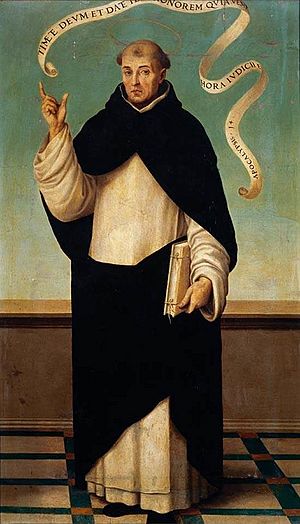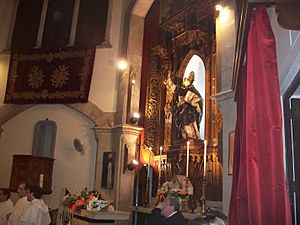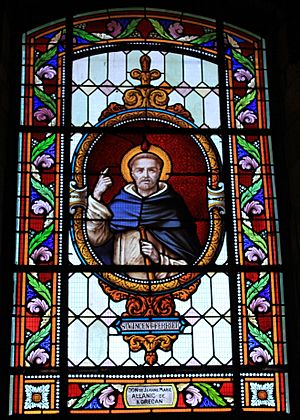Vincent Ferrer facts for kids
Quick facts for kids SaintVincent Ferrer OP |
|
|---|---|

San Vicente Ferrer by Juan de Juanes
|
|
| Priest and Confessor | |
| Born | 23 January 1350 Valencia, Kingdom of Valencia |
| Died | 5 April 1419 (aged 69) Vannes, Duchy of Brittany |
| Venerated in | |
| Canonized | 3 June 1455, Santa Maria sopra Minerva, Papal States by Pope Callixtus III |
| Major shrine | Cathedral of Vannes Vannes, Morbihan, France, Bogo, Cebu, Philippines, Calape, Bohol, Banay-banay, Lipa City, Philippines, in Iglesia Filipina Independiente (IFI) Diocesan Shrine in Old Town San Remigio, Antique, Philippines, Diocesan of San Vicente Ferrer, Brgy. Mamatid, Cabuyao, Philippines and IFI Cathedral in Odiongan, Romblon, Philippines. |
| Feast | 5 April |
| Attributes | |
| Patronage |
|
Vincent Ferrer (born January 23, 1350 – died April 5, 1419) was a famous Dominican friar and preacher from Valencia, a region in modern-day Spain. He was known for his powerful speeches and his work as a missionary, spreading the Christian message. Today, he is honored as a saint in the Catholic Church.
Contents
Early Life and Education

Vincent was the fourth child of Guillem Ferrer and Constança Miquel. His father was a notary, which is like a public official who deals with legal documents.
There are many stories about Vincent's birth. One legend says that a Dominican friar told his father in a dream that his son would become famous worldwide. Another story claims his mother felt no pain when he was born. He was named after Saint Vincent Martyr, who was the patron saint of Valencia.
From a young age, Vincent was very religious. He would fast on Wednesdays and Fridays, meaning he would eat very little or no food on those days. He also gave money and goods to people in need.
He started his studies when he was eight years old. By the time he was fourteen, he was already studying theology (the study of religious faith) and philosophy (the study of knowledge and existence).
Joining the Dominican Order
When Vincent was eighteen, he joined the Dominican Order. This group of friars is also known as "Black Friars" because of the black cloak they wear over their white habits.
Joining the order was not easy for Vincent. He faced many challenges and temptations to leave. Even his parents asked him to become a regular priest instead. But Vincent prayed and practiced self-discipline to overcome these difficulties. He successfully completed his first year of training and officially joined the order.
For three years, Vincent focused only on reading the Bible. He studied it so much that he memorized it all. After becoming a full member of the order, he wrote a book about logic. In 1379, he became a Catholic priest in Barcelona.
He later earned a doctorate in theology from the University of Lleida. This made him an expert in religious studies.
What Vincent Looked Like
People described Vincent Ferrer as a man of average height. He had a high forehead and clear, distinct facial features. His hair was light-colored, and he had a tonsure, which is a shaved patch on the head worn by some monks. His eyes were very dark and expressive, and he had a gentle manner. He was usually pale, but his voice was strong and powerful, sometimes gentle, and always clear.
The Great Schism and Vincent's Role
During Vincent's lifetime, the Western Schism (1378–1417) caused a big problem in the Catholic Church. It was a time when there were two, and later even three, people claiming to be the Pope at the same time. One Pope lived in Avignon, France, and another in Rome, Italy.
Vincent believed that the Pope in Rome, Urban VI, was not the true Pope. He supported the Pope in Avignon, Clement VII. After Clement VII died, Cardinal Pedro de Luna was chosen as the next Pope in Avignon, taking the name Benedict XIII.
Vincent and his brother, Boniface, were very loyal to Benedict XIII. Vincent worked for him as an important advisor. However, Vincent also tried to convince Benedict XIII to step down to help end the schism. When Benedict XIII refused to resign, he lost support and was eventually removed from his position in 1417.
Vincent later said that this difficult time in the Church made him very sad and even caused him to become seriously ill.
Amazing Gifts and Missionary Journeys
For 21 years, Vincent traveled to many countries, including England, Scotland, Ireland, France, Switzerland, and Italy. He preached the Gospel (the Christian message) and helped many people become Christians.
Many people believe that Vincent could only speak Catalan, his native language. However, they say he had the gift of tongues, meaning he could be understood by people speaking other languages. He was known as a very powerful preacher. Even though he was a scholar, his sermons were easy for everyone to understand. He used simple language and direct messages.
He even preached to Colette of Corbie, a famous nun, and her sisters. She told him that he would die in France. Vincent became too ill to return to Spain and indeed passed away in Brittany, France, in 1419.
Today, fishermen in Brittany still ask for his help during storms. In Spain, he is known as the patron saint of orphanages, which are homes for children without parents.
The Compromise of Caspe
Vincent also played a key role in a major political event in his home region. In 1410, the King of Aragon, Martin of Aragon, died without a clear heir. Five different people claimed the throne.
To solve this problem, a committee of nine respected leaders was formed. Three members came from each of the three main regions: Aragon, Catalonia, and Valencia. Vincent was chosen as one of the representatives for Valencia.
He voted for a prince from Castile named Ferdinand of Antequera. On June 28, Vincent publicly announced that Ferdinand would be the new King of Aragon. This important process, which decided the next king, is known as the Compromise of Caspe.
Death and Lasting Impact
Vincent Ferrer died on April 5, 1419, in Vannes, France, when he was 69 years old. He was buried in Vannes Cathedral.
He was made a saint by Pope Calixtus III on June 3, 1455. His feast day, which is a special day to remember him, is celebrated every year on April 5.
Many things are named after him, including a religious group called the Fraternity of Saint Vincent Ferrer. There are also two towns in Brazil named after him: São Vicente Ferrer, Maranhão and São Vicente Ferrer, Pernambuco.
In 2019, a very tall statue of Saint Vincent Ferrer, measuring 50 meters (164 feet) high, was built in Bayambang, Philippines.
Images for kids
See also
 In Spanish: Vicente Ferrer (santo) para niños
In Spanish: Vicente Ferrer (santo) para niños
- Monastery of Sant Jeroni de Cotalba
- Saint Vincent Ferrer, patron saint archive
- Statues of Saints Vincent Ferrer and Procopius, Charles Bridge



